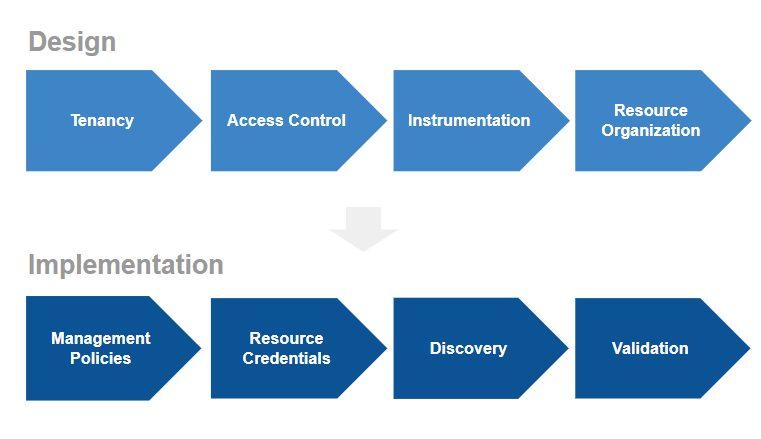Introduction
Onboarding is the process of a setting up OpsRamp to discover and manage your environment. Onboarding involves a set of design and implementation steps, as described below.

Onboarding Process
Tenancy
OpsRamp’s tenancy capabilities give you many choices in partitioning your managed environment into clients. Designing a structure for how your environments are partitioned into clients is a key choice that you need to make up front.
Once your IT resources are onboarded into one tenancy structure, moving to a different structure is possible, but involves effort. Therefore, it is best to explore choices and select a structure that best suits your organization. The core choice to make is what a client represents - for example, a client can represent:
- Business units or departments
- Locations where you resources are deployed - public cloud accounts, data centers
- Operational state of you resources - development, staging or production resources
Access control
OpsRamp’s access control capabilities give you many choices to authenticate and grant permissions to your users. Designing an access control model up front, before you onboard resources is important.
Here are core choices to make:
- Single sign-on (SSO): Using an external SSO system or OpsRamp’s native authentication.
- Two-Factor authentication: Requiring two-factor authentication to access OpsRamp.
- Client level users: Allowing user accounts at the client level or limiting user accounts at the organization (partner) level.
- Roles: How many distinct roles and associated access level to have.
Instrumentation strategy
OpsRamp offers different types of instrumentation to collect data from your environment. A key decision to make as part of onboarding is to decide what types of instrumentation to use for different types of resource.
Resource organization
OpsRamp offers these constructs to organize your resources into logical categories:
- Resource Groups: A logical grouping of resources.
- Sites: A groups of resources residing in the same geographical location.
- Service Maps: A logical grouping of resource that all participate in an IT service.
These constructs will help you manage your environment at scale, by help you view and reason about classes of resources instead of individual resources.
Management policies
OpsRamp’s resource management policies simplify onboarding new resources by automating actions within OpsRamp. Through these policies, you can effect these actions on resources, as soon as they are discovered:
- Assign monitoring templates
- Assign availability definitions
- Associate knowledge base articles
- Associate credentials
- Assign jobs
- Assign custom attributes
Resource credentials
To discover and monitor your resources, OpsRamp needs credentials to access your resources to collect data. For example, OpsRamp needs SNMP credentials to manage for SNMP enabled resources. OpsRamp offers a credential store these credentials. As part of the onboarding process, you need to collect these credentials from with your organization and place them in OpsRamp’s credential store.
Discovery
The keystone step in the onboarding process is to run discovery against your environment, so that OpsRamp can find and onboard your resources. OpsRamp supports different types of integrations for discovery. You will configure and run discovery integrations suited for the resources that you want to onboard into OpsRamp.
Validation
The final step in the onboarding process is to validate that the resources that you intended to onboard are properly onboarded into OpsRamp. You can do a quick sanity check in OpsRamp’s dashboard and infrastructure list page to see if your resources are visible. The recommended approach to do a thorough audit of the onboarding process is to use OpsRamp’s reporting capabilities. You will run reports to see the following:
- A complete inventory of onboarded resources.
- Availability status of onboarded resources.
What to do next
- See the Instrumentation Guide for a detailed discussion.